MAIN FUNCTIONS OF PHYTOACTIVES
HELPS IN THE CONTROL OF HARMFUL MICROORGANISMS,
ACTING AS GROWTH PROMOTERS, ANTIBACTERIAL,
ANTI-INFLAMMATORY, ANTIPARASITIC, ANTIOXIDANT AND
IMMUNOMODULATORY
CONTROL OF BACTERIAL PATHOGENS
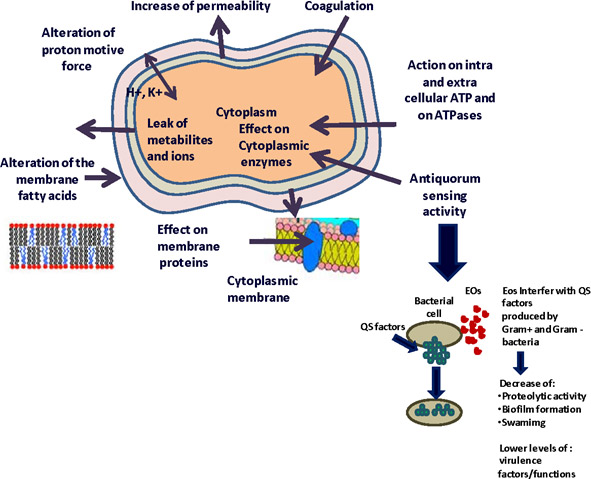
Phytoactives impact different structures of pathogenic bacteria:
1. Coagulation of proteins in the cytoplasm;
2. Increased permeability of membranes;
3. Change in the driving force of the proton;
4. Leakage of metabolic and ions;
5. Modification of fatty acids in membranes;
6. Impact on membrane proteins;
7. Impact on cytoplasm enzymes;
8. Impact on ATP and ATPases;
9. Strong activity of ANTI-QUORUM SENSING;
10. Acting on the immune system to increase phagocytosis and produce specific antibodies.
Main mechanism:
ANTI-QUORUM SENSING GRAM-NEGATIVE AND GRAM-POSITIVE
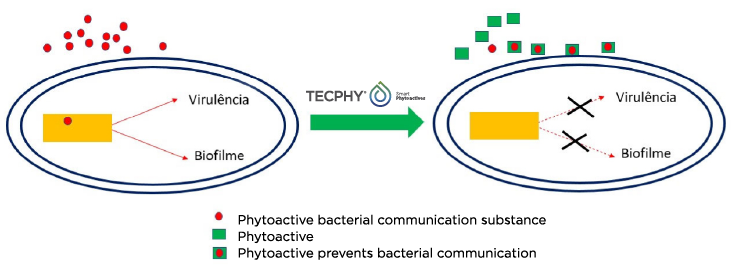
Phytoactives are active present in essential oils of aromatic plants, generated by the secondary metabolism of vegetables, which have different forms of action on pathogenic microorganisms, being used as important tools in the prevention and control of infections in animal organisms.
Since Phytoactives are typically lipophilic compounds, they have the ability to cross plasma membranes and accumulate in them, modifying their permeability. In this process, metabolites and ions modify their serum concentrations, as a consequence of changes in the proton motive force, altering the cytoplasmic pH, making it more acidified by the accumulation of H+ protons. These ion and pH changes force the cell to use various metabolic activities in an attempt to reach homeostasis, but without success, culminating in the depletion of energy, in the form of ATP, and cell death.
In the cytoplasm they act by denaturing and coagulating proteins, deconfiguring the normal metabolism of the cell. Enzymatic proteins, present both in the cytosol and in the membrane, also undergo the action of Phytoactives, and enhance cellular degenerative action, especially ATPases that directly influence energy metabolism. The bacterial genetic material is also affected, increasing the bacteriostatic effect, by directly influencing the decrease in bacterial division.
The bactericidal effect is observed in Phytoactives, because the alterations caused by them lead to the impairment of vital metabolic processes in the cell, and the increase in membrane permeability, with extravasation of cell contents, culminates in cell lysis and cell death.
Another interesting effect of phytoactives on bacterial communities is the action anti-quorum sensing about bacteria gram-negative and gram-positive. Bacteria have a communication system, quorum sensing, performed via the release of chemical substances, used for population protection, multiplication of individuals, and tissue invasion. When bacteria identify adverse conditions, they initiate communication and release polymeric substances that act as a protective film against external agents, the biofilm.
Bacterial colonies enveloped in this matrix have their virulence enhanced and acquire a higher resistance to antibiotics, which is an aggravating factor in the fight against diseases. Phytoactives act on bacteria by affecting the production of these communication substances and their receptors on the cell membrane, disrupting this mechanism and preventing biofilm formation and reducing pathogenic action.
When we add Phytoactives to the diets of production animals, there is also a stimulation of the immune system, which is very important for maintaining health and fighting infections. The immune system can be stimulated in both ways: innate (natural) or acquired (adaptive). Both have their actions enhanced when we compare groups of animals supplemented with Phytoactives with those that did not receive them.
In innate immunity, it is the amount and type of defense cells in the body that have a direct action on infections and diseases. The somatic cells that make up the innate system are neutrophils, eosinophils, granulocytes, basophils, mast cells, dendritic cells, monocytes, macrophages, and natural killer cells. These cells act in the body by identifying infections and imbalances and fighting pathogens and their implications. The defense cells in the different tissues act by phagocytosing, releasing inflammatory mediators, and producing cytokines and antigen-presenting molecules. Animals receiving phytoactives show higher amounts of these cell groups in their serum levels.
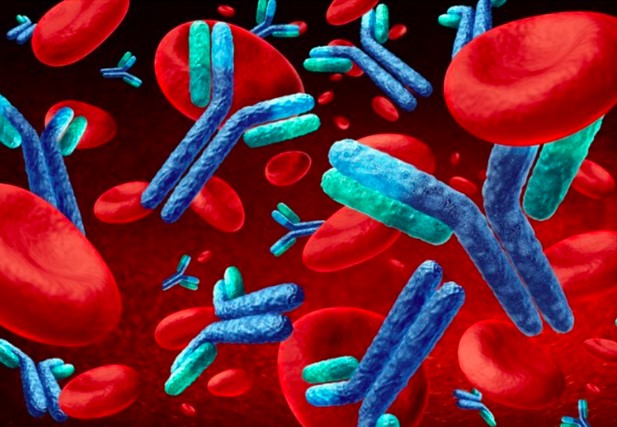
In the acquired immune system, it is antibodies that have an action on pathogenic organisms or substances produced by them. The production of antibodies is specific to the aggressor agent, which can be a virus, bacterium or substance produced by them, or a vaccine response.
Upon contact with an antigen the T and B lymphocytes are activated and start the production of antibodies, which are secreted by the cell and reach the lymphatic and blood circulation. Animals that are supplemented with Phytoactives have their immune response enhanced, and it has been observed in experiments that their blood antibody titers are higher than expected in non-supplemented animals, which improves the defense of organisms against pathogens and enhances vaccine protection, and its use combined with vaccination periods is highly recommended.
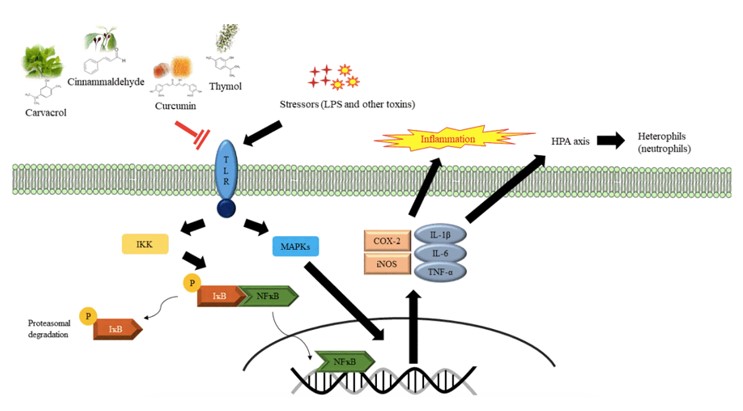
The addition of Phytoactives in the diets of animals has an anti-inflammatory effect, decreasing exacerbated cellular responses to infections or irritating compounds, such as ammonium gas, preserving cellular integrity, decreasing swelling and fluid accumulation, and preserving basal energy.
They act mainly in reducing the production of pro-inflammatory cytokines, which are indicators and signaling agents of inflammatory responses. Thus, the tissues will present less irritation, redness, temperature and pain sensation, contributing to the fastest local recovery. Intensely inflamed tissues tend to produce injuries, which can lead to the entry of bacteria and/or viruses, which, due to the lack of tissue homeostasis, can trigger diseases.
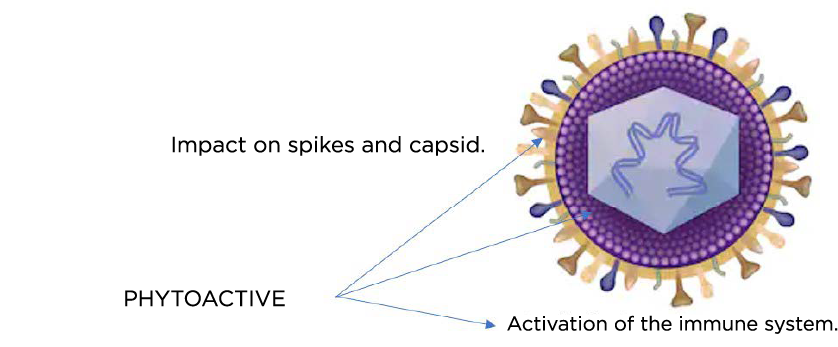
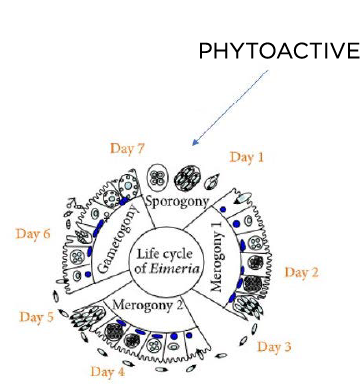
In viral infections commonly faced by production animals, Phytoactives also have an important function that directly impact on their infective capacity. Viruses are very simple acellular beings that obligatorily need to parasitize cells for their reproduction and survival.
For this purpose, viruses have glycoprotein structures in their membrane, the spikes, which they use to enter the host cell. These spikes act as “keys” that make the cells allow the fusion between the viruses and their plasmatic membranes to take place. Phytoactives act on these spikes, modifying their usual structure, impacting their infecting power, preventing them from penetrating the plasmatic membranes. Thus, the use of Phytoactives in production animals have the ability to reduce the virulence of pathogens, preventing viral infection.
Positive effects on the infection of protozoa in production animals are also observed when Phytoactives are included in diets. The genus Eimeria spp. it is composed of a category of obligate intracellular protozoa, with a complex biological cycle and with a tropism by the intestine of animals. They cause diarrhea of great zootechnical impact in different species, called eimeriosis or coccidiosis. Coccidia carry out three typical phases for their dispersion and reproduction: sporogony phase that occurs in the environment and two other phases, merogony (asexual reproduction) and gametogony (sexual reproduction), in the intestinal cells of the host. Phytoactives act in the sporogony and merogony phase, cleaving the parasite cycle, reducing its population and infecting power.
In addition to actions on the immune system and on potentially pathogenic organisms, Phytoactives also have the ability to directly impact on the respiratory system, term sensation and on the intestinal health of animals.
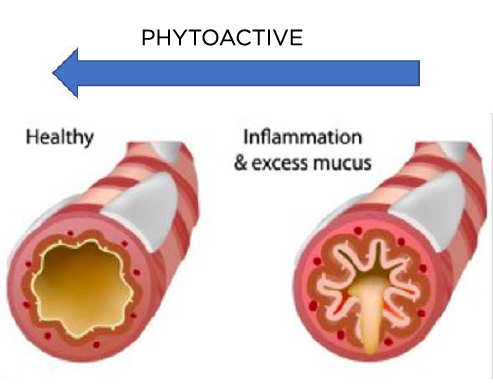
Some Phytoactives, when added via drinking water or by nebulization on animals have a positive impact on the respiratory system, especially in cases of infection and inflammation. Upon entering the respiratory tract, Phytoactives act by decreasing the inflammatory response of the bronchial mucosa, the production of secretions and mucus, and the swelling of the lung tissues, relieving the main symptoms of respiratory disorders.
Together with these actions, Phytoactives have bronchodilator effect, increasing the flow of air to the lungs, improving oxygenation and breathing of animals. These actions have a direct impact on animal health and well-being, together with the proven immunological, virucide and bactericidal effect, preventing and treating dysbiosis and respiratory infections in breeding animals.
In the same form of ministry, some Phytoactives present in the essential oils of cinnamon, eucalyptus and mint are able to mitigate caloric stress in animals in adverse temperature situations. These compounds act on the sensory heat receptors and are able to generate a feeling of freshness, causing direct impact on thermal stress and decreasing the usual physiological responses that occur when the critical temperature of each animal species is reached. By generating this cold sensation in the animals ' organisms, lower rates of hormones linked to stress situations, unchanged ethology and adequate zootechnical rates are observed, when compared to animals in the same situation without the use of Phytoactives. Together with this important action, the products reduce inflammations, improve the immune response and ensure health and productivity. Research indicates that these Phytoactives pose bacteriostatic and bactericidal effect for strains of various microorganisms such as Streptococcus pyogenes, Escherichia coli, Candida albicans, Staphylococcus aureus, Acinetobacter baumannii and Klebsiella pneumoniae, resulting in lower rates of infections by these pathogens. Another important and interesting impact of these Phytoactives is the reduction of the sensation of pain and discomfort, which directly impacts on animal welfare and production. In animal production situations in the tropics, thermogenic Phytoactives are not recommended, as they increase the sensation of heat and have an impact on thermal stress.
TERM SENSATION
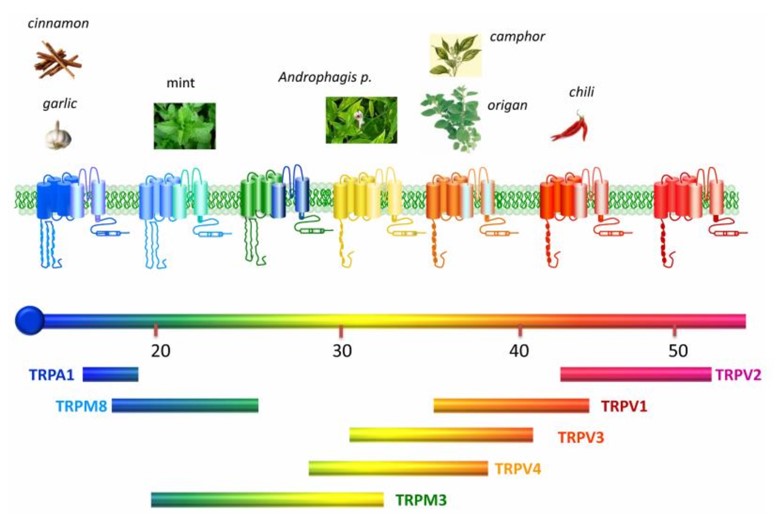
Phytoactives interact with temperature receptors:
1. Phytoactives such as cinnamon, mint and eucalyptus create a feeling of cold;
2. Combinations of selected Phytoactives reduce the sensation of pain;
3. The Phytoactive of pepper increases the sensation of heat, unwanted in our climate.
Within the sanitary and zootechnical context, the maintenance of intestinal integrity and the modulation of the Microbiota are very important guidelines. The integrity of the intestinal mucosa is directly related to the productivity and health of production animals. Higher amounts of mucus are found protecting the intestinal epithelium of animals that receive Phytoactives in the diet, being this essential substance for protection against the aggression of enzymes and potentially degenerative substances, adding more this action to the protection and intestinal integrity. An uninjured mucosa ceases to be a gateway for pathogen infection, and a healthy epithelium is capable of better absorption of nutrients coming from the diet.
When a pathogen causes damage to intestinal cells, changes in the ability to digest and absorb nutrients can occur, with the appearance of inflammation in the intestinal mucosa, therefore, a modification in the height of the villi. In addition, there is a thickening in the intestinal wall resulting from inflammation that has as a consequence a decrease in the absorption capacity and the accumulation of nutrients, which are precursors of dysbiosis.
In research, the use of Phytoactives promoted a preservation of enterocytes and a lower cell renewal, with antioxidant effects, which decreases basal energy expenditure. In addition, it promotes a greater villus/crypt ratio, increasing the absorptive contact surface with the digestion, promoting a greater use of the digestion, together with a greater intestinal enzymatic activity. This enhanced activity is the result of gastric and intestinal stimulation of the production of digestive enzymes, which begins in the olfaction and gustation of diets supplemented with Phytoactives. These actions increase the amount of metabolizable energy available for animal production, improving zootechnical rates and with growth promoting effect.
The intestinal flora is directly impacted when Phytoactives are included in the diet. Pathogenic organisms, gram-positive and gram-negative, when they come into contact with Phytoactives are affected by bacteriostatic and bactericidal actions, reducing their populations and thus losing their competitive capacity in the Microbiota. In this way, beneficial bacteria increase their populations, such as lactic acid bacteria, modulate the microbiome to their benefit, making it inhospitable to other species and further decreasing the infective capacity of potentially pathogenic ones. Under great population pressure of beneficial bacteria and affected by the action of Phytoactives, bacteria have their virulence minimized, benefiting the intestinal and general health of animal organisms.
IMPROVE INTESTINAL INTEGRITY:
BENEFICIAL MODULATION OF MICROBIOTA AND INTESTINAL MUCUS
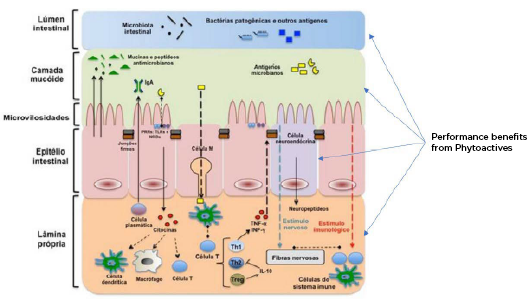
Rodrigo, F.A.P. et al. Physiology of The Intestinal Epithelial Barrier. In: ORIÁ, R. B.; BRITO, G. C. Sistema digestório: integração básico-clínica. São Paulo: Blucher, 2016.
Phytoactives improve nutrient absorption:
1. Beneficial modulation of Microbiota;
2. Reduction of pathogenic strains in Intestinal Microbiota;
3. Improvement of the mucoid layer, protecting the microvilli;
4. Increased vilo/crypt ratio;
5. Increased enzyme activity;
6. Improved metabolizable energy.